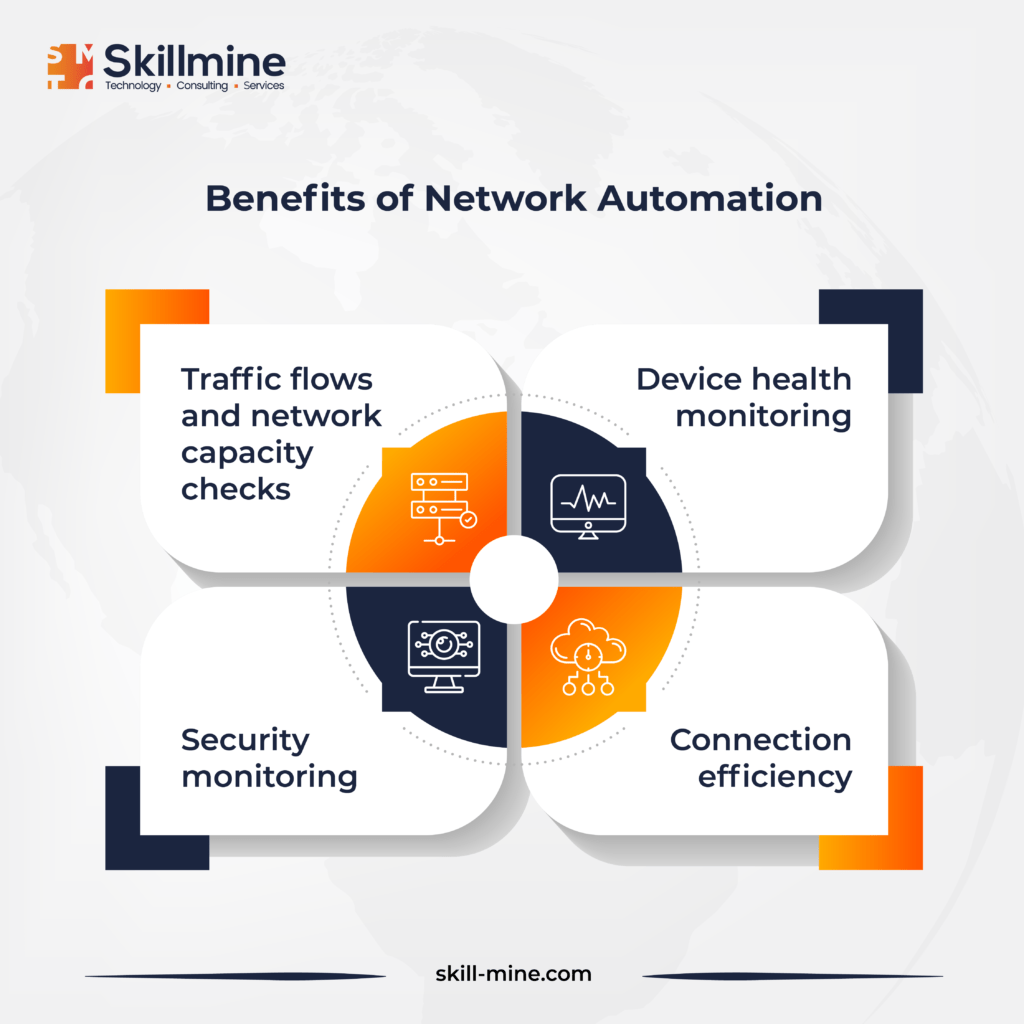The rise of network automation tools in recent times signifies a transformation in the way administrators construct and oversee networks. While server and application automation tools have been present for a while, those specifically tailored for networks (NOC tools) have gained popularity only in the past few years.
Historically, manual procedures have predominantly handled configuration setup and continuous network modifications. However, network automation tools have ushered in a departure from these manual practices. Although various network automation tools may adopt different methods, the shared objective of NOC service providers is to minimize the time administrators dedicate to routine and straightforward configuration processes.
What is Network Automation?
Network automation revolutionizes the management and operation of computer networks by employing automated processes and tools. It replaces manual configurations with programmable commands, enhancing efficiency, accuracy, and agility in network tasks. Network automation streamlines repetitive operations, minimizing errors and significantly reducing the time required for routine activities. This transformative technology encompasses various aspects, from configuration management and device provisioning to troubleshooting and security enforcement. By embracing network automation, organizations can achieve faster deployment, better resource utilization, and improved scalability, ultimately empowering IT teams to focus on strategic initiatives and innovation rather than repetitive maintenance tasks in the dynamic landscape of modern networking.

Characteristics of Network Automation Tools
Network automation tools can automate configuration modifications in diverse vendor environments. They achieve this by automating command-line syntax and subsequently applying these changes to each device that necessitates the update. Automation tools generate configuration scripts instead of requiring a network administrator to initiate Secure Socket Shell (SSH) sessions into every router, switch, and firewall for manual text-based configuration alterations, accomplishing the same objective more efficiently and with fewer errors.
Types of Network Automation Tools
Network automation tools can be classified into infrastructure automation tools, purpose-built network automation tools, and software-defined platform tools.
Initially designed for server and application automation, infrastructure automation tools have expanded their scope to include network functions. These tools are advantageous for enterprises already employing them for infrastructure and DevOps tasks. While cost-effective and familiar to IT staff, some may lack comprehensive network automation features and compatibility with diverse network hardware and software.
On the other hand, purpose-built network automation tools offer specialized functionalities tailored for network management. However, they might contribute to “tool glut” if numerous administration tools are used.
What is ‘Tool Glut’?
“Tool glut” in network automation refers to the excessive use of redundant tools, leading to complexity and inefficiency. It highlights the importance of carefully selecting and integrating tools to streamline network automation processes effectively.
Software-defined platforms create a logical overlay on LAN hardware, simplifying central management and orchestration of configurations in multivendor environments with frequent LAN setting changes.
Popular Network Automation Tools
Ansible:
Initially designed for Linux-based systems, Ansible evolved into an open-source platform acquired by Red Hat in 2015. Offering specialized modules for various network vendors, Ansible facilitates functions like device discovery, configuration, testing, and drift identification. With hundreds of pre-built network modules, it integrates seamlessly into environments where server, application, and development teams already use Ansible.
Beyond Edge Networks:
Formerly iPhotonix, BeyondEdge Networks started in carrier access networking and expanded into enterprise LAN with its software-defined LAN (SD-LAN) platform. This vendor-agnostic solution overlays existing switching vendors or white box technologies, accommodating copper or fiber networks. BeyondEdge SD-LAN automates network discovery, creating a visual model of Layer 2 connectivity while templates configure LAN services.
BMC True Sight Automation for Networks:
BMC’s standalone platform, TrueSight Automation for Networks, emphasizes a security-focused approach to network automation. It integrates with BMC’s larger TrueSight AIOps platform, offering tools for operations management, network orchestration, and server automation. Automation for Networks addresses vulnerabilities, compliance checks, and configuration verifications, supporting various vendors, including Arista, Cisco, Dell, and Juniper.
Chef Enterprise Automation Stack:
Chef, an open-source automation tool, presents its commercially available Chef Enterprise Automation Stack (EAS) for comprehensive features and professional support. Widely adopted for server and development tasks, Chef EAS requires client software installation on network devices. This facilitates the automation of various network configuration tasks, offering compatibility with major vendors such as Arista, Cisco, F5, and Juniper.
Manage Engine Network Configuration Manager:
A division of Zoho Corporation, ManageEngine’s Network Configuration Manager is a purpose-built, multivendor platform with features for network change management, configuration storage, compliance enforcement, and auditing. Leveraging automation templates called configlets, it streamlines repetitive tasks and monitors compliance with regulatory standards. The platform supports routers, switches, firewalls, and other devices from vendors like Cisco, Dell, Fortinet, and Juniper and includes a smartphone app for on-the-go management.
Puppet Enterprise:
Puppet, a popular infrastructure automation tool, offers Puppet Enterprise, adding essential features for network automation. While open source, Puppet Enterprise provides additional modules for network automation tasks. Requiring installation of networking modules, Puppet supports Cisco IOS, IOS XE, Nexus hardware, Palo Alto PAN-OS firewalls, Lenovo switches, and F5 Local Traffic Manager load balancers.
Solar Winds Network Configuration Manager:
SolarWinds, a veteran in network automation, offers the Network Configuration Manager, which is compatible with various vendors. Beyond typical automation, it integrates with the National Vulnerability Database for continuous vulnerability assessments. Integration with other SolarWinds tools, such as Network Performance Monitor, enhances its capabilities for comprehensive network management.
VMware vRealize Automation:
Following the acquisition of SaltStack, VMware rebranded and integrated it into vRealize Automation, focusing on security and network automation alongside NSX. This tool simplifies the setup and management of NSX-controlled hybrid and multi-cloud data center environments. Offering a self-service portal, it automates VMs, Kubernetes clusters, and security policies, ensuring consistency across on-premises and cloud locations. Ideal for organizations heavily relying on VMware NSX, vRealize Automation ensures synchronized deployment of network and security services.
Conclusion
The network automation tools listed here address specific facets of your network management. An effective network automation platform is crucial in assisting administrators construct and manage corporate networks. Skillmine’s Network Operation Center services help businesses ensure seamless connectivity and optimized performance, leading to increased operational efficiency.
Looking for expert technology consulting services? Contact us today.





